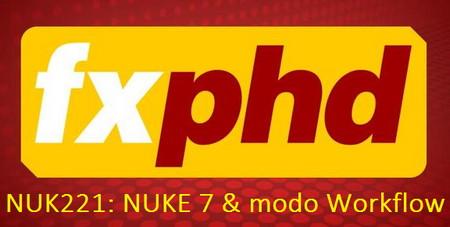
fxphd - NUK221: NUKE 7 and modo Workflow
English | AVC1 1440x900 24 fps | AAC 64 Kbps 44.1 KHz |9.73 GB
Genre: eLearning
With the recent merger of Luxology and The Foundry this course will bridge the gap between modo and NUKE. Working our way through four main projects we explore various aspects of modo including modeling, animation, dynamics, shading, lighting and rendering. We also explore over two dozen new NUKE 7 features and see how these two industry leaders can work together to produce some great visual effects shots. The course is being run jointly by Matt Leonard and close friend Ben Greasley.
DOWNLOAD
Matt Leonard has been in the 3D and visual effects industry for 20 years. He has spoken at various events and shows on behalf of Autodesk, The Foundry and eyeon Software and has had articles published in various magazines and journals. He is a member of the Visual Effects Society and has worked as a beta tester for Maya, Arnold, RenderMan, Mari and NUKE. He currently runs his own on-site training company in the UK and has trained artists from companies such as ILM, Pixomondo, MPC and Framestore.
Ben Greasley has been in the 3D industry for the last 11 years working in multiple disciplines. He has a broad understanding of the entire visual effect pipeline, with an emphasis on 3D modeling, lighting, rendering and compositing. He has worked as a beta tester for modo, Arnold, V-Ray and Nuke. He currently works with Matt as a senior trainer, specializing in modo, Maya, Arnold, Houdini and NUKE.
class syllabus
Class 1: In this first class we look at modo's recoil dynamic simulation solver. Based on the 'Bullet' physics engine we look at a number of key features including; active and passive rigid body objects, collision interactions, constraints, and settings within the solver itself. We then look at exporting the simulation as an alembic cache and the considerations we should make when doing so.
Class 2: In our second class we continue with the project Ben started last week. We take the Alembic Cache from modo into Nuke 7 and add Shaders, Lights, a Camera move and more. We also look at Nuke 7's new features in Alembic Support, ScanlineRendering and various Viewer Enhancements.
Class 3: In our third class we start our second main project. We start by loading in the background plate, removing the lens distortion and tracking the plate. From there we look at the PointCloudGenerator and ModelBuilder nodes.
Class 4: In our forth class we continue our second main project moving into Modo. We start by loading in the alembic file from Nuke and adding the undistorted background plate. From there we rebuild and extend the geometry and create additional background geometry for projection within nuke.
Class 5: In our fifth class we're back in Nuke for the third part of our Brooklyn Bridge project. We start by looking at a straightforward way of cleanup a section of the original plate. For there we look at projecting the main matte painting onto the geometry Ben made is modo last week. Next we add a burning car to the plate, a flag blowing in the wind and a smoke plume. After replacing the sky we add a 3D rendered jet fighter complete with water reflection and finish up the lesson looking at Grain, Concatenation, and the new Timeclip node.
Class 6: In our sixth class we finish up our Brooklyn Bridge project. We start by looking at how we build a fake HDR image which was supplied to 3D for lighting the plane. From there we look at building a Master Control to speed up workflow through the project. Next we look at creating 3D fog, contact lighting on the burning car, heat refraction from the plane's engine and a custom light wrap and edge blur. We then finishing the shot by adding depth of field. We finish the class by looking at the new Depth Generator, Vector Blur and Motion Blur nodes.
Class 7: In our seventh class we're in Modo focusing on the render engine, and methods of outputting render passes for compositing in Nuke. We spend time looking at the different render quality settings, the methods of global illumination. Then work our way through the methods of creating Passes, and groups of passes.
Class 8: In our eighth class we are takes all the passes created in class 7 and recombining them in Nuke. We will be looking at the methods of combining the shader passes to create out final image, and some of the options available to us from the AOV passes.
Class 9: In our ninth class we start our last project, a shot from Moving Day, the short film by Jason Wingrove. In this class we cover camera tracking, cleanup and matte creation in Nuke, and UV Mapping in modo.
Class 10: In our final class we finish our Moving Day project. We start the class by looking at the new Tracker which was updated in Nuke 7 before looking at adding in a back wall to the hallway. From there Ben shows us how to create a projection setup in modo before we use that as our outside environment. We then add window reflections via the Environmental Light node. Finally we add the finishing touches using various integration tricks
http://rapidgator.net/file/8cdf3f92b5e49699384f3fcfe432ec2c/fxphd.NUK221.NUKE.7.and.modo.Workflow.part02.rar.html
http://rapidgator.net/file/94edc374e10cd16780ab95a19fc5df15/fxphd.NUK221.NUKE.7.and.modo.Workflow.part03.rar.html
http://rapidgator.net/file/47aca5ba323dddbf5b54b08dcf6c96f9/fxphd.NUK221.NUKE.7.and.modo.Workflow.part04.rar.html
http://rapidgator.net/file/19e3b9d9b77ea350ecb8bc037023f680/fxphd.NUK221.NUKE.7.and.modo.Workflow.part05.rar.html
http://rapidgator.net/file/ca5eda89cd685894ca7583e4f4a78565/fxphd.NUK221.NUKE.7.and.modo.Workflow.part06.rar.html
http://rapidgator.net/file/427be2a204d5a83e25758b821bb70e8b/fxphd.NUK221.NUKE.7.and.modo.Workflow.part07.rar.html
http://rapidgator.net/file/b252ebccd692585cb8e8387300c3bb14/fxphd.NUK221.NUKE.7.and.modo.Workflow.part08.rar.html
http://rapidgator.net/file/510e6a88c172e553515cd96de80bb1ad/fxphd.NUK221.NUKE.7.and.modo.Workflow.part09.rar.html
http://rapidgator.net/file/1a0e78fd4cd3810fd9083c108e8a5242/fxphd.NUK221.NUKE.7.and.modo.Workflow.part10.rar.html
http://ul.to/8x14dnx9
http://ul.to/ro8cmwu3
http://ul.to/8o3baxtk
http://ul.to/sr9wik9l
http://ul.to/5ggv5y5d
http://ul.to/tm9kf1t2
http://ul.to/pueuu9tq
http://ul.to/4s9x4ibt
http://ul.to/cvrr4mlb
http://ul.to/ys67b5fb
TO MAC USERS: If RAR password doesn't work, use this archive program:
RAR Expander 0.8.5 Beta 4 and extract password protected files without error.
TO WIN USERS: If RAR password doesn't work, use this archive program:
Latest Winrar and extract password protected files without error.

